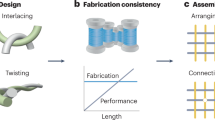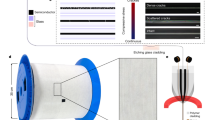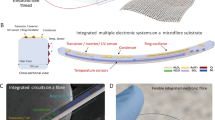Abstract
Virtually all electronic and optoelectronic devices necessitate a challenging assembly of conducting, semiconducting and insulating materials into specific geometries with low-scattering interfaces and microscopic feature dimensions. A variety of wafer-based processing approaches have been developed to address these requirements, which although successful are at the same time inherently restricted by the wafer size, its planar geometry and the complexity associated with sequential high-precision processing steps. In contrast, optical-fibre drawing from a macroscopic preformed rod is simpler and yields extended lengths of uniform fibres. Recently, a new family of fibres composed of conductors, semiconductors and insulators has emerged. These fibres share the basic device attributes of their traditional electronic and optoelectronic counterparts, yet are fabricated using conventional preform-based fibre-processing methods, yielding kilometres of functional fibre devices. Two complementary approaches towards realizing sophisticated functions are explored: on the single-fibre level, the integration of a multiplicity of functional components into one fibre, and on the multiple-fibre level, the assembly of large-scale two- and three-dimensional geometric constructs made of many fibres. When applied together these two approaches pave the way to multifunctional fabric systems.
This is a preview of subscription content, access via your institution
Access options
Subscribe to this journal
Receive 12 print issues and online access
$259.00 per year
only $21.58 per issue
Buy this article
- Purchase on Springer Link
- Instant access to full article PDF
Prices may be subject to local taxes which are calculated during checkout


Fig. 2a,b © 2005 OSA

Fig. 3c,d,e © 2006 WILEY



© 2006 OSA


Similar content being viewed by others
References
Maurer, R. D. & Schultz, P. C. Fused silica optical waveguide. US patent 3,659,915 (1972).
Keck, D. B., Maurer, R. D. & Schultz, P. C. On the ultimate lower limit of attenuation in glass optical waveguides. Appl. Phys. Lett. 22, 307–309 (1973).
Senior, J. M. Optical Fiber Communications: Principles and Practice (Prentice Hall, New Jersey, 1985).
Agrawal, G. P. Fiber-Optic Communication Systems 3rd edn (Wiley-Interscience, New York, 2002).
Marcuse, D. Theory of Dielectric Optical Waveguides (Academic, New York, 1974).
Ramaswami, R. & Sivarajan, K. N. Optical Networks: A Practical Perspective (Morgan Kaufmann, San Francisco, 1998).
Knight, J. C. et al. All-silica single-mode optical fiber with photonic crystal cladding. Opt. Lett. 21, 1547–1549 (1996).
Birks, T. A., Knight, J. C. & Russell, P. S. Endlessly single-mode photonic crystal fiber. Opt. Lett. 22, 961–963 (1997).
Cregan, R. F. et al. Single-mode photonic band gap guidance of light in air. Science 285, 1537–1539 (1999).
Yablonovitch, E. Inhibited spontaneous emission in solid-state physics and electronics. Phys. Rev. Lett. 58, 2059–2062 (1987).
John, S. Strong localization of photons in certain disordered dielectric superlattices. Phys. Rev. Lett. 58, 2486–2489 (1987).
Joannopoulos, J. D., Meade, R. D. & Winn, J. N. Photonic Crystals: Molding the Flow of Light (Princeton Univ. Press, New Jersey, 1995).
Knight, J. C. Photonic crystal fibres. Nature 424, 847–851 (2003).
Russell, P. Photonic crystal fibers. Science 299, 358–362 (2003).
Nguyen, H. et al. A new slant on photonic crystal fibers. Opt. Express 12, 1528–1539 (2004).
Yeh, P., Yariv, A. & Marom, E. Theory of Bragg fiber. J. Opt. Soc. Am. 68, 1196–1201 (1978).
Winn, J. N. et al. Omnidirectional reflection from a one-dimensional photonic crystal. Opt. Lett. 23, 1573–1575 (1998).
Fink, Y. et al. A dielectric omnidirectional reflector. Science 282, 1679–1682 (1998).
Fink, Y. et al. Guiding optical light in air using an all-dielectric structure. J. Lightwave Technol. 17, 2039–2041 (1999).
Temelkuran, B. et al. Wavelength-scalable hollow optical fibres with large photonic bandgaps for CO2 laser transmission. Nature 420, 650–653 (2002).
Hart, S. D. et al. External reflection from omnidirectional dielectric mirror fibers. Science 296, 510–513 (2002).
Benoit, G. et al. Static and dynamic properties of optical microcavities in photonic bandgap yarns. Adv. Mater. 15, 2053–2056 (2003).
Bayindir, M. et al. Metal-insulator-semiconductor optoelectronic fibres. Nature 431, 826–829 (2004).
Benoit, G. et al. Dynamic all-optical tuning of transverse resonant cavity modes in photonic bandgap fibers. Opt. Lett. 30, 1620–1622 (2005).
Shapira, O. et al. Surface-emitting fiber lasers. Opt. Express. 14, 3929–3935 (2006).
Bayindir, M. et al. Fiber photodetectors codrawn from conducting, semiconducting and insulating materials. Opt. Photon. News 15, 24 (2004).
Bayindir, M. et al. Integrated fibres for self-monitored optical transport. Nature Mater. 4, 820–825 (2005).
Bayindir, M. et al. Thermal-sensing fiber devices by multimaterial codrawing. Adv. Mater. 18, 845–849 (2006).
Abouraddy, A. F. et al. Large-scale optical-field measurements with geometric fibre constructs. Nature Mater. 5, 532–536 (2006).
Rayleigh, L. On the stability of jets. Proc. London. Math. Soc. 10, 4–13 (1878).
Rayleigh, L. On the capillary phenomena of jets. Proc. R. Soc. London 29, 71–97 (1879).
Rayleigh, L. On the instability of a cylinder of viscous liquid under capillary force. Phil. Mag. 34, 145–154 (1892).
Tomotika, S. On the instability of a cylindrical thread of a viscous liquid surrounded by another viscous fluid. Proc. R. Soc. London A 150, 322–337 (1935).
Eggers, J. Nonlinear dynamics and breakup of free-surface flows. Rev. Mod. Phys. 69, 865–929 (1997).
Hilton, A. R. Optical properties of chalcogenide glasses. J. Non-Cryst. Solids 2, 28–39 (1970).
Sanghera, J. S. & Aggarwal, I. D. Active and passive chalcogenide glass optical fibers for IR applications: A review. J. Non-Cryst. Solids. 257, 6–16 (1999).
Varshneya, A. K. Fundamentals of Inorganic Glasses (Academic, New York, 1994).
Borisova, Z. U. Glassy Semiconductors (Plenum, New York, 1981).
King, W. A., Clare, A. G. & Lacourse, W. C. Laboratory preparation of highly pure As2Se3 glass. J. Non-Cryst. Solids. 181, 231–237 (1995).
Seddon, A. B. Chalcogenide glasses - A review of their preparation, properties and applications. J. Non-Cryst. Solids. 184, 44–50 (1995).
Southworth, G. C. High frequency wave guides — general considerations and experimental results. Bell System Tech. J. 15, 284–309 (1936).
Warters, W. D. WT4 millimeter waveguide system - Introduction. Bell System Tech. J. 56, 1825–1827 (1977).
Alsberg, D. A., Bankert, J. C. & Hutchison, P. T. WT4-WT4a millimeter-wave transmission-system. Bell System Tech. J. 56, 1829–1848 (1977).
Mitra, P. P. & Stark, J. B. Nonlinear limits to the information capacity of optical fibre communications. Nature. 411, 1027–1030 (2001).
Verdaasdonk, R. M. & van Swol, C. F. P. Laser light delivery systems for medical applications. Phys. Med. Biol. 42, 869–894 (1997).
Renn, M. J. et al. Laser-guided atoms in hollow-core optical fibers. Phys. Rev. Lett. 75, 3253–3256 (1995).
Constant, E. et al. Optimizing high harmonic generation in absorbing gases: Model and experiment. Phys. Rev. Lett. 82, 1668–1671 (1999).
Schnurer, M. et al. Guiding and high-harmonic generation of sub-10-fs pulses in hollow-core fibers at 1015 W/cm2. Appl. Phys. B 67, 263–266 (1998).
Miyagi, M. & Kawakami, S. Design theory of dielectric-coated circular metallic waveguides for infrared transmission. J. Lightwave Technol. 2, 116–126 (1984).
Hongo, A. et al. Transmission of kilowatt-class CO2-laser light through dielectric-coated metallic hollow wave-guides for material processing. Appl. Opt. 31, 5114–5120 (1992).
Miyagi, M. & Nishida, S. A proposal of low-loss leaky wave-guide for submillimeter waves transmission. IEEE Trans. Microwave Theory. 28, 398–400 (1980).
Desterke, C. M., Bassett, I. M. & Street, A. G. Differential losses in Bragg fibers. J. Appl. Phys. 76, 680–688 (1994).
Kuriki, K. et al. Hollow multilayer photonic bandgap fibers for NIR applications. Opt. Express. 12, 1510–1517 (2004).
Harrington, J. A. A review of IR transmitting, hollow waveguides. Fiber Integrated Opt. 19, 211–227 (2000).
Dai, J. W. & Harrington, J. A. High-peak-power, pulsed CO2 laser light delivery by hollow glass waveguides. Appl. Opt. 36, 5072–5077 (1997).
Strong, M. S. & Jako, G. J. Laser surgery in larynx: Early clinical experience with continuous CO2-laser. Ann. Oto. Rhinol. Laryn. 81, 791–798 (1972).
Shapshay, S. M. & Beamis, J. F. Use of CO2-laser. Chest 95, 449–456 (1989)
Anastassiou, C. et al. Fibers deliver CO2 laser beams for medical applications. Photon. Spectra. 38, 108 (2004).
Holsinger, F. C. et al. Use of the photonic band gap fiber assembly CO2 laser system in head and neck surgical oncology. Laryngoscope 116, 1288–1290 (2006).
Devaiah, A. K. et al. Surgical utility of a new carbon dioxide laser fiber: Functional and histological study. Laryngoscope 115, 1463–1468 (2005).
Jacobson, A. S., Woo, P. & Shapshay, S. M. Emerging technology: Flexible CO2 laser waveguide. Otolaryn. Head Neck 135, 469–470 (2006).
Pfeiffer, G., Paesler, M. A. & Agarwal, S. C. Reversible photodarkening of amorphous arsenic chalcogens. J. Non-Cryst. Solids. 130, 111–143 (1991).
Shimakawa, K., et al. A model for the photostructural changes in amorphous chalcogenides. Phil. Mag. Lett. 77, 153–158 (1998).
Ntziachristos, V., Bremer, C. & Weissleder, R. Fluorescence imaging with near-infrared light: new technological advances that enable in vivo molecular imaging. Eur. Radiol. 13, 195–208 (2003).
Koncar, V. Optical fiber fabric displays. Opt. Photon. News 16, 40–44 (2005).
Llyoyd, J. M. Thermal Imaging Systems (Plenum, New York, 1975).
Dereniak, E. L. & Boreman, G. D. Infrared Detectors and Systems (Wiley, New York, 1996).
Ahn, D. H. et al. A nonvolatile memory based on reversible phase changes between fcc and hcp. IEEE Electron Dev. Lett. 26, 286–288 (2005).
Liu, B. et al. Characteristics of chalcogenide nonvolatile memory nano-cell-element based on Sb2Te3 material. Microelectron. Eng. 82, 168–174 (2005).
Sun, Z. M., Zhou, J. & Ahuja, R. Structure of phase change materials for data storage. Phys. Rev. Lett. 96, 055507 (2006).
Lenz, G. et al. Large Kerr effect in bulk Se-based chalcogenide glasses. Opt. Lett. 25, 254–256 (2000).
Asobe, M. et al. 3rd-order nonlinear spectroscopy in As2S3 chalcogenide glass-fibers. J. Appl. Phys. 77, 5518–5523 (1995).
Spalter, S. et al. Strong self-phase modulation in planar chalcogenide glass waveguides. Opt. Lett. 27, 363–365 (2002).
Asobe, M. et al. laser-diode-driven ultrafast all-optical switching by using highly nonlinear chalcogenide glass-fiber. Opt. Lett. 18, 1056–1058 (1993).
Gopinath, J. T. et al. Third order nonlinearities in Ge-As-Se-based glasses for telecommunications applications. J. Appl. Phys. 96, 6931–6933 (2004).
Ranka, J. K., Windeler, R. S. & Stentz, A. J. Visible continuum generation in air-silica microstructure optical fibers with anomalous dispersion at 800 nm. Opt. Lett. 25, 25–27 (2000).
Birks, T. A., Wadsworth, W. J. & Russell, P. S. Supercontinuum generation in tapered fibers. Opt. Lett. 25, 1415–1417 (2000).
Slusher, R. E. et al. Large Raman gain and nonlinear phase shifts in high-purity As2Se3 chalcogenide fibers. J. Opt. Soc. Am. B 21, 1146–1155 (2004).
Ruan, Y. L. et al. Wavelength dispersion of Verdet constants in chalcogenide glasses for magneto-optical waveguide devices. Opt. Comm. 252, 39–45 (2005).
Johnson, S. G. et al. Low-loss asymptotically single-mode propagation in large-core OmniGuide fibers. Opt. Express 9, 748–779 (2001).
Ibanescu, M. et al. Analysis of mode structure in hollow dielectric waveguide fibers. Phys. Rev. E 67, 046608 (2003).
Shapira, O. et al. Complete modal decomposition for optical waveguides. Phys. Rev. Lett. 94, 143902 (2005).
Acknowledgements
The authors are indebted to John D. Joannopoulos for his support, dedication and vision without which the results reported would not have materialized. We thank S. Johnson, M. Soljacic, M. Ibanescu, J. Arnold, D. Deng, D. Saygin-Hinczewski and J-F. Viens. This work was supported by US Army ISN, ONR, AFRL, NSF, US DOE and DARPA. We also thank the RLE for its support. This work was also supported in part by the MRSEC Program of the National Science Foundation.
Author information
Authors and Affiliations
Corresponding author
Ethics declarations
Competing interests
The authors declare no competing financial interests.
Rights and permissions
About this article
Cite this article
Abouraddy, A., Bayindir, M., Benoit, G. et al. Towards multimaterial multifunctional fibres that see, hear, sense and communicate. Nature Mater 6, 336–347 (2007). https://doi.org/10.1038/nmat1889
Issue Date:
DOI: https://doi.org/10.1038/nmat1889
This article is cited by
-
Flexible fibres take fabrics into the information age
Nature (2024)
-
Optical \(\varvec{\nu }\)-conformable normalized and recursional electroosmotic optimistic \(\varvec{\nu }\)-conformable energy
Optical and Quantum Electronics (2024)
-
Optical Heisenberg antiferromagnetic electroosmotic magnetic torque microscale
Optical and Quantum Electronics (2024)
-
Fabrication Techniques and Sensing Mechanisms of Textile-Based Strain Sensors: From Spatial 1D and 2D Perspectives
Advanced Fiber Materials (2024)
-
Revolutionizing Wearable: Multicolored Photochromic Fiber Opens New Frontiers in Human–Machine Interaction
Advanced Fiber Materials (2024)



